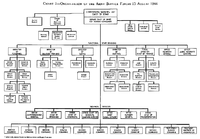Army Service Forces
The Army Service Forces were one of the three autonomous components of the Army of the United States during World War II, the others being the Army Air Forces and Army Ground Forces. They were created on 28 February 1942 by Executive Order Number 9082 "Reorganizing the Army and the War Department" and War Department Circular No. 59, dated 2 March 1942.[1]
| Army Service Forces | |
|---|---|
 Army Service Forces Shoulder Sleeve Insignia. | |
| Active | 9 March 1942 – 11 June 1946 |
| Country | United States |
| Branch | |
| Commanders | |
| Notable commanders | Lieutenant General Brehon B. Somervell |
Origins
In March 1942, there was a sweeping reorganization of the Army. This was the result of dissatisfaction with the existing structure, with the United States Army Air Forces in particular seeking greater autonomy. However, the main driver was the Chief of Staff, General George Marshall, who felt overwhelmed by the large number of officers and agencies—at least 61—with direct access to him.
The Chief of Staff wanted no more than three commands reporting to him, so everything which did not fit into the Army Ground Forces or Army Air Forces became part of the Services of Supply, which were renamed the Army Service Forces on 12 March 1943, as it was felt that the term "supply" did not accurately describe their broad range of activities.

Army Service Forces, throughout the war under the command of General Brehon B. Somervell, brought together elements of five different components of the Army: elements of the War Department General Staff, especially its G-4 component; the Office of the Under Secretary of War; the eight administrative bureaux; the nine corps areas, which became the service commands; and the six supply arms and services, which became known as the technical services.
Technical Services
Six Technical Services found themselves part of Army Service Forces when they were grouped in 1942: the Corps of Engineers, Signal Corps, Ordnance Department, Quartermaster Corps, Chemical Corps and Medical Corps. A seventh technical service, the Transportation Corps, was established as the Transportation Division on 28 February 1942 under Executive Order 9082. It was renamed the Transportation Service in April 1942 and became a corps in its own right on 31 July 1942. The Transportation Corps took over control of the ports of embarkation, regulating points and railways.
Unlike the chiefs of the combat arms, who had their offices abolished and their authority transferred to the Chief of Army Ground Forces, neither the duties nor the structure of the technical services were altered by their becoming part of the Army Service Forces, but their status changed, and the chiefs no longer had direct access to the Chief of Staff or the Secretary of War.
Each of the Technical Services ran its own procurement and field depots.
Insignia
According to the website of the U.S. Army Institute of Heraldry, the insignia of the Army Service Forces consisted of "a blue five-pointed star, one point up, 13⁄8 inches in diameter on a white background within a red border, outside diameter 21⁄4 inches, inside invected of six." The patch was approved on 30 July 1941 and has had numerous designations.
It was redesignated as the "Army Service Forces" patch in March 1943; "Technical and Administrative Services" in June 1946; and "DA Staff Support" in 1969. The shoulder-sleeve insignia is now authorized for personnel assigned to Department of the Army Field Operating Agencies.[2] From 1980 through 2006 it was worn by members of the United States Army Trial Defense Service.
Service Commands
|
|
References
Further reading
- Army Service Forces, Organization Manual, M 301, Washington, D.C.: Army Service Forces, Department of the Army, 1943
- Millett, John D. (1954), The Organization and Role of the Army Service Forces, Washington, D.C.: Office of the Chief of Military History, Department of the Army
- Ohl, John Kennedy (1994), Supplying the Troops: General Somervell and American Logistics in World War II, DeKalb, Illinois: Northern Illinois Press, ISBN 0-87580-185-4
- Smith, R. Elberton (1959), The Army and Economic Mobilization, Washington, D.C.: Office of the Chief of Military History, Department of the Army, ISBN 0-16-023939-7